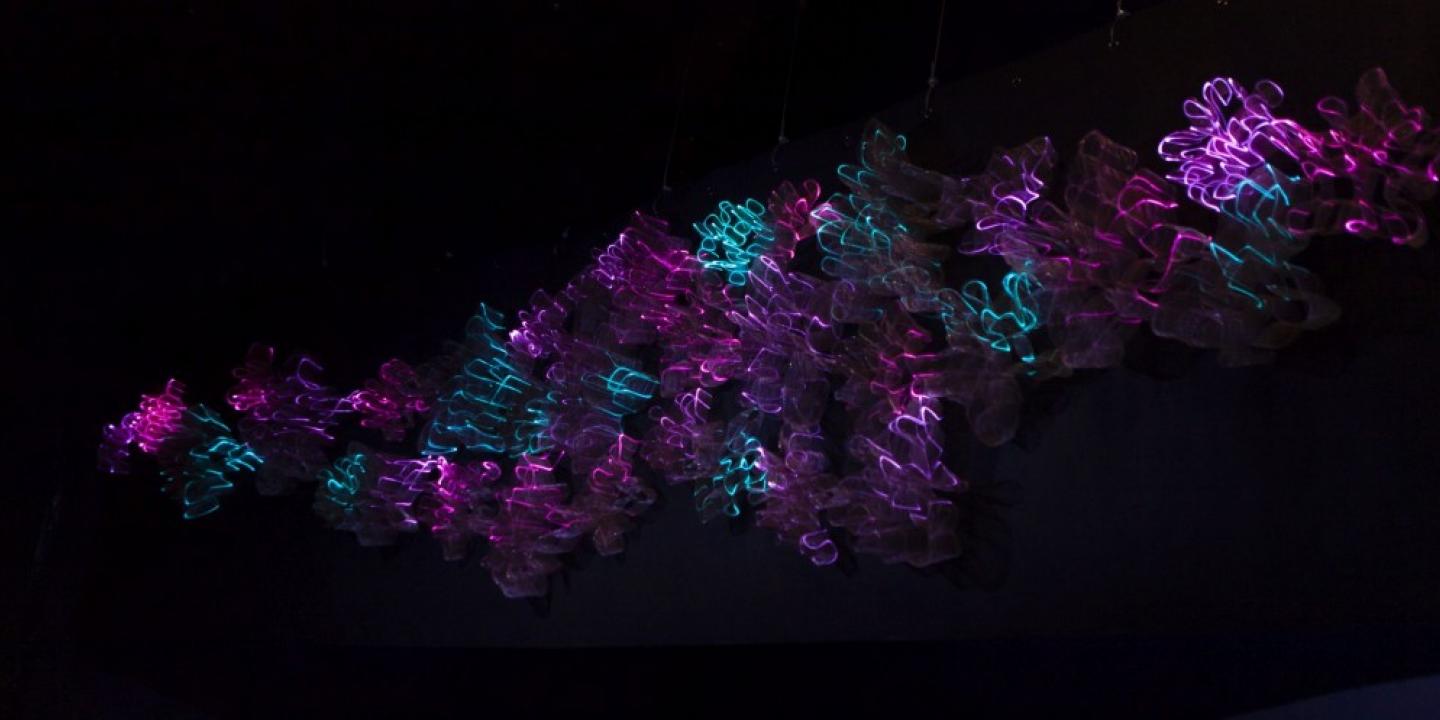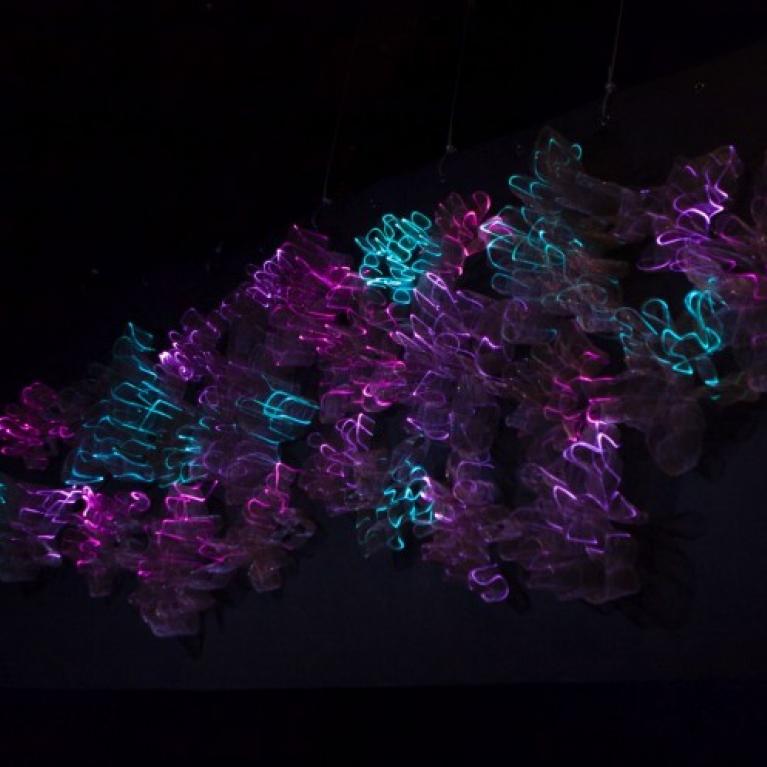Tradition and Innovation | Latvian Textile Art
On Tuesday, 15 June 2021, the large-scale exhibition of the Latvian textile art will be opened at the National Museum of Decorative Arts in Madrid and visitors could view it until 5 September.
The exhibition Tradition and Innovation | Latvian Textile Art (Tradición y modernidad I Arte textil de Letonia) at the Spanish National Museum of Decorative Arts (Museo Nacional de Artes Decorativas) is organized to celebrate the 100th anniversary of the establishment of Latvian-Spanish diplomatic relations. This historical event happened on 9 April 1921.
Latvian textile art is shown in Madrid for the first time, so the exhibition is designed with the idea to reflect the most characteristic features of its evolution and provide Spanish viewers with a comprehensive picture of the history, traditions and modern innovations of the Latvian textile art field. The core of the exhibition is formed by the most outstanding works of the collection of the Latvian National Museum of Art / Museum of Decorative Arts and Design. It is supplemented by significant works from private collections created during recent years by the most prominent artists in the field. In total, the Latvian school of textile art is represented by 48 outstanding works created by 29 authors. These include both the middle and older generation of recognized textile art authorities and the new generation of artists who have just graduated from the Art Academy of Latvia. In order to reflect various aspects of the development of textile art, the exposition includes large-format tapestries, 3-dimentional fiber art objects as well as miniature textiles.
Textile art has always formed an essential part of Latvian culture and has always been a particularly popular art field. It has deep and historically determined traditions rooted in the inheritance of folk art values and professional skills. The evolution of the branch can be traced from archaeological artefacts to ethnographic heritage and the beginnings of the development of professional art, which, like in several other European countries, began at the end of the 19th century. The achievements of textile art at the beginning of the 20th century and especially in the 1920s – 1930s, during the independence of Latvia, should be noted. It was during this period that artists Jūlijs Madernieks, Ansis Cīrulis, Jūlijs Straume, Arveds Dzērvītis and others made a significant contribution to the development of textile design with the creation of the national style. Textile art was part of the Latvian exposition at the World Exhibitions in Paris (1925 and 1937) and Brussels (1935).
During the years of Soviet occupation after the World War II, the evolution of the professional textile art school was essentially stimulated after the establishment of the Textile Art Department at the Art Academy of Latvia in 1961, which still provides artists with higher professional education. A special role was played by its founder and long-term Head of the Department, Professor Rūdolfs Heimrāts (1926–1992). Under his leadership various directions of textile art expressions developed, different techniques and materials were implemented, folk art heritage and values of the world art history as well as topical innovative trends of the world stage (especially French and Polish schools) were investigated, large-scale figural tapestries were woven and spatially avant-garde solutions created. This year marks 60 years since the department was founded and during this time more than 300 artists have graduated it. Many of them are very active in their professional career in Latvia and abroad.
Conceptually, the exhibition is divided into two parts: historical (or traditional) and contemporary. In a separate hall viewers can enjoy the special dedications of the famous Latvian artist Edīte Pauls-Vīgnere to Spain – the worksCorrida, Steps and coronettes Miró I, II – the dedication to the outstanding Spanish artist Juan Miró. Although Edīte Pauls-Vīgnere has never visited Spain, deep in her heart she has always held a love for Spanish art and culture.
The historical part of the exhibition is composed with the idea to emphasize some of the main aspects important for artistic concepts which played a significant role in the development of textile art of 1960s – 1980s and beginning of 1990s; as well as to point out the most outstanding authors. These are Latvian traditions – Song and Dance Festival, folk art and folk costumes (Rūdolfs Heimrāts, Pēteris Sidars), folk festivals – like Midsummer traditions (Aija Baumane), beauty of Latvian nature – Baltic Sea and Latvian rural landscape (Egils Rozenbergs, Inga Skujiņa), as well as impressions from travelling and influences from different cultures, historical periods and schools (Rūdolfs Heimrāts, Edīte Pauls-Vīgnere, Aina Muze, Lilita Postaža).
The selected large-format textile compositions from the “gold fund” of the Latvian National Museum of Art are the works of Rūdolfs Heimrāts and his students. Although tapestry was the main weaving technique of those years, various author’s techniques, fiber art, textile mosaics, felting, etc. developed in parallel. Textile art actively entered not only exhibition halls, but also was designed for public interiors and gained widespread popularity in the nation, as it was freer in artistic terms and was not a subject to such ideological pressure as fine art. Essentially important aspect in the development of the textile art were the artists’ own interest, creativity, exhibition activities and, of course, the support of museums.
The restoration of Latvia’s independence in 1991 and Latvia’s return to Europe, which paved the way for various challenges – innovations and experiments in the field, was chosen as the border-line for the representation of contemporary textile art. However, the opening of borders, which facilitated the travel opportunities of artists, went hand in hand with the economic problems experienced by the artist’s industries, which also had a significant impact on the development of textile art. The size of the works decreased and the time consuming traditional tapestry technique gradually lost its popularity. Alongside the traditional tapestry, digital tapestry (which became popular among the new generation) and other technical possibilities came. Conceptual works emerged, storytelling priorities changed, recycling processes and fiber art (including paper, metal fiber, various alloys, laminations, etc.) gained widespread popularity. Also the interest in the use of handicraft techniques in another – contemporary cut – gradually revived. In recent years, the trend towards contemporary communication with the public has become increasingly important, so interactive textiles, video textiles, the convergence of different genres and brand new phenomena – “smart fabrics” and electronic textiles – are entering the exhibition halls.
The works have been selected for the exposition with the idea of giving an insight into this wide range of thematic, used materials and techniques. Along with such well-known authors as Egils Rozenbergs, Ieva Krūmiņa, Baiba Osīte and others, innovative solutions of young artists are also relatively widely represented – Rolands Krutovs, Elīna Ģibiete, Diāna Kokoreviča, Ieva Prāne, Diāna Janušone, etc.
It is worth to emphasize that at the beginning of the 21st century, Latvia became a center of international textile art events. Since 2001, the Riga International Textile and Fiber Art Triennials (2001, 2004, 2007, 2010, 2015, 2018) have been organized, which have become world-renowned and created preconditions for dynamic cooperation between artists and museums of different coyuntries. Our artists also regularly participate in various international exhibitions and competitions, winning well-deserved awards.
Edīte Pauls-Vīgnere is one of the most talented, popular and versatile artists in Latvia. Her creative career, which began fifty years ago, is still active today. An experimenter, an innovator, an outstanding textile art professional – this could briefly describe her contribution.
Until the 1990s, the artist’s main form of expression was large-format tapestries and fascinating three-dimensional textile ensembles based on nature’s, travel and universal themes. The master’s works have always been characterized by a particularly decorative, active color flower and an emotionally uplifting mood, which still does not cease to surprise the audience. Wool was used as a basic material by the artist, but in the mid-1990s Edīte Pauls-Vīgnere begins to get interested in various experiments, incl. creating fantastic solutions with synthetic fabrics and fibers. Applique, textile mosaics, structural solutions or semi-voluminous soft textile sculptures were created by sewing, embroidering, melting, shaping and supplementing the works with attractive details. In this technique she created impressive series of textiles dedicated to women, theater, a fashion art guru, or a deeply global social or political conceptual idea. In recent years a new form of expression has entered the author’s creative work: crowns or “coronets” (as the artist herself calls them) and the bead technique, which has become popular in both large compositions and miniature paintings.
Exhibition is organized by the Latvian National Museum of Art in the cooperation with the National Museum of Decorative Arts in Madrid and the Embassy of the Republic of Latvia in the Kingdom of Spain. The project was implemented thanks to the financial support from the Ministry of Foreign Affairs of the Republic of Latvia and the State Culture Capital Foundation of Latvia.
Exhibition curator:
Mg. art. Velta Raudzepa, Collection Manager at the Museum of Decorative Arts and Design / Latvian National Museum of Art

